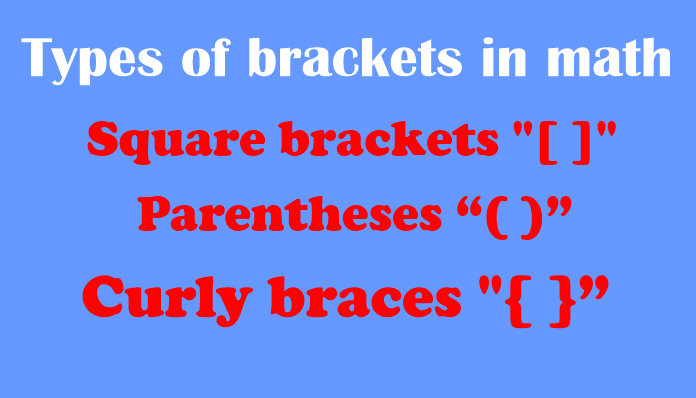"Let's Share, Sharing is Caring"
In mathematics, the brackets are used to expression the groups and indicate the order of the operations. Commonly three types of brackets used in mathematics, parentheses “( )”, square brackets “[ ]”, and curly braces “{ }”. These brackets are crucial for clarifying calculations and determining the priority of operations in complex equations. Parentheses usually have the highest precedence, followed by square brackets and then curly braces. By using brackets, mathematicians can avoid ambiguity and ensure that expressions are evaluated correctly. For example, “(3 + 5) × 2” differs from “3 + (5 × 2)” due to the brackets, highlighting the significance of their use in mathematical notation.

Understanding the Basics of Brackets:
We’ll start by introducing the three main types of brackets commonly used in algebra: parentheses, square brackets, and curly braces. Each type has distinct functions and precedence in mathematical operations, and understanding these basics is essential for mastering algebraic expressions.
Use Parentheses ( ) With Examples:
Parentheses are used in algebra to group numbers and operations together. They tell the reader which operations should be performed first, according to the order of operations. The order of operations is a set of rules that mathematicians use to determine the order in which operations should be performed in an equation.
The order of operations is as follows:
- Parentheses
- Exponents
- Multiplication and division (from left to right)
- Addition and subtraction (from left to right)
For example, in the equation (2 + 3) * 5, the parentheses tell us to add 2 and 3 first. Then, we multiply the result by 5. So, the answer to the equation is 30.
If there are multiple sets of parentheses in an equation, we solve the innermost set first, then the next innermost set, and so on. For example, in the equation (2 + (3 * 4)) * 5, we would first solve the equation inside the innermost parentheses, which is 3 * 4 = 12. Then, we would add 2 to 12, which is 14. Finally, we would multiply 14 by 5, which is 70. So, the answer to the equation is 70.
Parentheses can also be used to group like terms together. For example, in the equation 2x + 3(x – 1), the parentheses group the terms x – 1 together. This allows us to combine the terms more easily, as follows:
2x + 3(x – 1) = 2x + (3x – 3)
= 5x – 3
As you can see, using parentheses can make it easier to read and solve algebraic equations.
Use of Square Brackets with Examples:
Square brackets are used in algebra in a few different ways.
- To group terms together. Just like parentheses, square brackets can be used to group terms together so that they are evaluated as a single unit. For example, the expression x + 5: x – 3 means the same thing as (x + 5)(x – 3).
- To denote the commutator of two operators. In group theory and ring theory, the commutator of two operators is denoted by the square brackets [a, b]. The commutator of two operators is defined as the difference between the product of the operators and the product of the operators in the opposite order. For example, the commutator of the operators a and b is [a, b] = ab – ba.
- To denote interval notation. In interval notation, square brackets are used to denote closed intervals. A closed interval is an interval that includes its endpoints. For example, the interval [1, 5] includes the numbers 1 and 5.
Here are some examples of how square brackets are used in algebra:
- x + 5: x – 3 = x^2 – 2x – 15
- [a, b] = ab – ba
- [1, 5] = {1, 2, 3, 4, 5}
I hope this helps! Let me know if you have any other questions.
Curly braces, also known as braces or brackets, are used in algebra to denote a set. A set is a collection of objects that are considered to be members of the same group. The curly braces are used to enclose the members of the set, and the order of the members does not matter. For example, the set of positive even numbers can be written as {2, 4, 6, 8, 10, …}.
Use of Curly braces with Examples:
Curly braces can also be used to group together parts of an expression. For example, the following expression:
(x + y) * (z – w)
could be written as:
{(x + y)} * {(z – w)}
The curly braces in this case indicate that the multiplication should be done first, and then the addition.
In some cases, curly braces can be used to denote a function. For example, the function that takes a number x and returns the square of that number can be written as:
f(x) = {x}^2
The curly braces in this case indicate that the square should be calculated first, and then the function should return the result. Overall, curly braces are a versatile tool that can be used in a variety of ways in algebra. They can be used to denote sets, group together parts of an expression, or denote a function. By understanding how to use curly braces, you can write more concise and accurate algebraic expressions.
Here are some additional examples of how curly braces can be used in algebra:
- To denote a range of numbers, such as {1, 2, 3, …, 10}.
- To denote a matrix, such as [[1, 2, 3], [4, 5, 6]].
- To denote a vector, such as <1, 2, 3>.
- To denote a permutation, such as {1, 3, 2}.
- To denote a combination, such as {1, 2, 3}C2.
As you can see, curly braces can be used in a variety of ways in algebra. By understanding how to use them, you can write more concise and accurate algebraic expressions.
